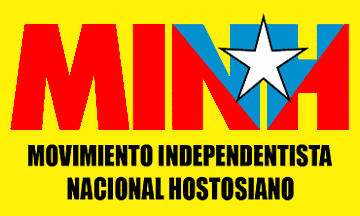
image by Javier Hernandez, 18 March 2006

Last modified: 2014-05-22 by zoltán horváth
Keywords: puerto rico | rainbow flag |
Links: FOTW homepage |
search |
disclaimer and copyright |
write us |
mirrors
See also:

image by Javier Hernandez, 18 March 2006
Movimiento Independentista Nacional Hostosiano (National
Hostosian Independence Movement) is a new and larger
independence/social justice organization founded by the
unification of two other independence/sovereignty groups: the
"Congreso Nacional Hostosiano (CNH)" and the
"Nuevo Movimiento Independentista Puertorriqueno
(NMIP)". They are not, nor strive to be, a political
- electoral party, instead they operate in Civil Society as an
autonomous organization. Currently, they are organizing
themselves at the national, regional, and municipal levels with
"base structures" and "specialized
organizations". At the present moment, their website is <www.redbetances.com>.
Logo at <capaprieto.tripod.com>.
Javier A. Hernandez, 15 April 2005
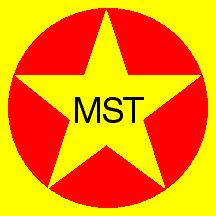
image by Ivan Sache, 19 January 2005
Photo of the MST flag is
at its newspaper.
Ron Lahav and Dov Gutterman, 18 January 2006
The Red Flag (Bandera Roja)
Bandera Roja is the newspaper of the Movimiento Socialista de
Trabajadores in Puerto Rico. The eponymous Red Flag, together
with various Socialist emblems, can be found on the masthead of
the paper, which can be seen at <www.bandera.org>.
Ron Lahav, 14 December 2005
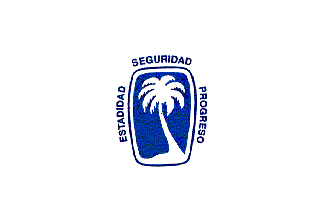
image by Victor Quinones , 12 Febuary 2000
blue palm tree on white - Statehood party.
Anna Stone Jimanez, 31 October 1998
The opposing party's (for statehood) symbol is the outline of
a palm tree on a blue background. The party's initials are PNP,
("Partido Nuevo Popular"?). Therefore, PPD is the party
of the "pava" and PNP is the part of the
"palma".
Steve Kramer, 15 December 1998
The New Progressive Pary is currently the governing party in
Puerto Rico while the PDP and the Independence Party are the
opossition. The spanish translation of the NPP is "Partido
Nuevo Progresista" not Partido Nuevo Popular. The flag of
the NPP is white with the NPP blue logo in the center. The party
motto is "Estadidad, Seguridad, Progreso" or
"Statehood, Security, Progress".
Victor Quinones , 12 Febuary 2000
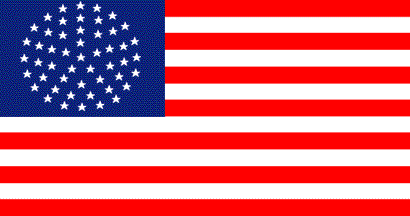
image by Andy Weir, 11 January 2001
51 star version of the United States flag commonly used by the
Puertorican statehood movement, . I dont know who designed it,
but it has been popular among statehood supporters in the island
for as long as Ican remember.
Victor Quinones, 20 September 2000
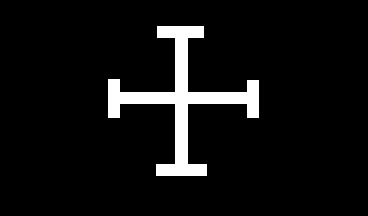
image by Carlos Torres, 22 January 2003
The PR flag was forbidden in the island from 1898 until 1952,
but was flown in defiance by the black-shirted Cadet Corps of the
Puerto Rico Nationalist Party. They also had a Cadet Corps' flag
all in black with a white Jerusalem Cross in the middle.
The best description of the cross would be a clockwise and a
counterclockwise swastika superimposed, leaving a cross made of
four "T" shapes joined at the long arm. The
Nationalists went down fighting the Commonwealth's National Guard
and Police in 1950, but recently, I've seen honor guards of the
PR pro-independence parties wearing the Cadets' black
cap/shirt/tie and white trousers uniform, and carrying the
Jerusalem Cross flag together with the PR flag.
Esteban Jimenez, 3 November 2000
The Puerto Rican Nationalist Party of New York (El Partido
Nationalista de Puerto Rico, Junta de Nueva York):
Our Cross - The flag of the Puerto Rican Nationalist Party (PNPR)
bears the organism's insignia. This is composed of a black
background with a white cross known as the Cross Potent or Potent
Cross in the center. The black color on the background of the
Nationalist flag symbolizes the mourning of the Puerto Rican
Nation in colonial captivity.
Crux Potent - The cross in itself, is an ancient symbol, utilized
forever in all religions and by all nations and it would be a
mistake to consider it an exclusive emblem of any particular
religion. When the Spanish conquistadors arrived at the sacred
land of the Aztecs the found the cross on their altars.
The cross with equal extremes or arms, also known as the Greek
Cross, is an ancient symbol, possibly the most ancient of the
symbols. The cross is found in every culture, even outside of the
Christian conception. It is found in all parts of the world, in
prehistoric caves and engraved on rocks. In the symbol of the
cross, God and Earth, Father and Mother are combined in harmony.
The vertical beam of the cross, stands for the heavenly or
spiritual, whereas the horizontal beam represents the material
plane of existence.
The intersection of the vertical phalus within the formal uterus
form the cross. The cross of initiation is phalic, the insertion
of the vertical phalus into the feminine ecteis forms the cross.
It is the cross of initiation, which we must carry over our
shoulders. With the fourth Arcana of the Tarot, the Being throws
over its shoulders the cross of initiation.
The cross has four ends. We understand that each tip is
representative of the four cardinal points of the earth: North,
South, East and West. They also represent the Age stages: Gold,
Silver, Copper, and Iron. The four seasons: Spring, Summer,
Winter and Fall. The four faces of the moon: New, Crescent, Half
and Full. The four elements: Air, Water, Land and Fire. The four
paths: Science, Philosophy, Art and Religion. As we talk about
the four paths we must understand that they are all just one.
This path is the narrow path of the edge of the blade, the road
of the revolution of the conscience.
We understand that by making an effort to give meaning to figures
and symbols, is how the spirit manages to elevate to the profound
and fundamental conceptions of human intelligence. In this way,
the spirit elevates with total independence, free, without
anything being dictated to it.
Our symbol and our flag are based on these principles. The Cross
Potent was used in seventeenth century alchemy as a sign for the
crucible, the pot in which for instance, metals are melted, a
melting pot. The cross is the most ancient symbol of the
crucible, which was called , cruzel, crucible or croiset in
French. In Latin, crucibulum, the root word crucible means crux,
cruces, or cross. It is evident that all this is an invitation to
reflection. It is in the crucible that the primal mater of the
great work suffers with great patience the passion of the Christ.
It is in the erotic crucible of sexuality, which the Ego dies and
the phoenix is re-born out from its own ashes. INRI, "In
Necis Renascor Integer". "In death be reborn intact and
pure."
The Cross Potent has arms with extremities which end in
"T" (taus). The cross-strokes at the ends of its
extremities are often said to represent the vault of the heavens.
Crosses are often associated with sky or sun gods. The Cross
Potent was such a symbol in ancient Mesopotamia. This cross is
also called the Windlass, a term linked with it in the Middle
Ages, and representing the four positions of the sun and the four
directions of the wind.
The Cross Potent has a peculiar symmetry; its four T's expand
into the cosmos. Symbolizing a point of encounter between the
celestial and the terrestrial worlds. Therefore, a mid point
between both "the center of the world". It is also
symbol of the tool and work of the celestial blacksmith, the
Demiurge, the universal soul and the work that forms destiny.
The four T's united at a point symbolize the soul, obtained from
the influence of the matter, through work and self-sacrifice and
elevated and separated from it, glorified and confirmed in it's
celestial vision and finally re-centered in the matter, but now
in perfect equilibrium; which speaks of the regeneration of a new
life. It also symbolizes the universal dissolving agent,
"primordial matter" of things, in which everything can
be fused together again.
"All of nature, all productions and all the creatures are
linked, and will be dissolved again in their own root, for the
nature of matter dissolves in what belongs only to its nature.
Those who have ears to hear, listen." - The Gospel According
to Thomas
The Cross Potent is also associated with the cross on which Jesus
Christ was crucified. Jesus Christ was actually crucified on a
tau, which was composed of two wooden beams in the shape of a
"T", and not on an actual cross. The Potent Cross can
be seen as four taus, directed towards the four cardinal points
or four directions of the winds (north, south, east and west) to
symbolize the universality of the Christ.
Carlos Torres, Nationalist Party of Puerto Rico, 22
January 2003
1) 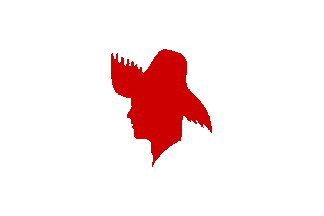
image by António Martins, 21 September 1999
2) 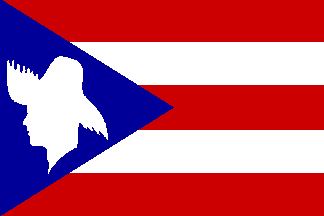
image by António Martins, 21 September 1999
Last night I saw on the news another attempt for a referendum
on statehood or independence (or maintain status quo) will be
held in Puerto Rico this year. In the news clip there was a
flag-frenzy of US flags, Puerto Rican flags, and at some (to me)
UFE's. There were so many flags, it was tough to distinguish, but
I think that one of the UFE's is: Current Puerto Rican flag, but
replace star with a cowboy hat (reliable viewing).
Rob Raeside, 5 March 1998
Red "jibaro" (country-dweller) on white (if someone
has used the PR flag and replaced the star with a "cowboy
hat" [the "pava" is a wide-brimmed woven straw hat
which used to be commonly used by field workers] I haven't seen
it, but I could believe that it has been done.) - Commonwealth
party.
Anna Stone Jimanez, 31 October 1998
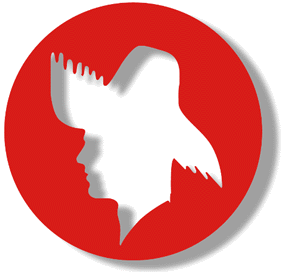
image from <www.pava.net>
The Partido Popular Democratico (popular democratic party)
flag is on
this web site: <www.pava.net>
. It is the" jibaro" (puertorrican field worker) face
and the" pava "(straw hat) in red. -
j. lopez rodriguez , 6 December 1998
Is this the flag or just the party's symbol?! I don't expect
to find this kind of shadow in a flag...
From the info provided, my educated guess is that the flag would
be this symbol (without shadow) on a white field. I say that it
is just a web graphic of the simbol.
Jorge Candeias, 9 December 1998
In the Israeli newspaper "Yediot Akhronot" of today
there is a picture from PR showing people waving flags of PAVA.
They are easy to recognize because of the logo that was posted
here few days ago. (and it is a logo since now I saw the flag).
The flag is of 2:3 white bedsheet. in its center the logo
(silouette of a man with an hat) in red. (the colors are just the
oposite to the colors of the logo which were white silouette on
red). around the lower half of the logo there is an inscription
in half circle. that says "PAN-TIERRA-LIBERTAD " or
something like that. In each of the corners of the bedsheet there
is a small variant of the central logo, including the
inscription, also in red.
Dov Gutterman , 15 December 1998
I asked one of my best friends, Nestor Rodriguez, for a
translation and explanation of the pava.net page. No specific
information on flags, but some interesting background which might
help us in further research.
'OK, this looks like a web page for the "Partido Popular
Democratico" (Popular Democratic Party), one of the two
major political parties in PR. This one's for the ELA, or
"Estado Libre Asociado" (Associated Free State), which
is the current position that the island has in US politics. As
you can see, the symbol for the party is a profile of a man
wearing a straw hat, or "pava". Thus the name of the
page.
Steve Kramer , 15 December 1998
The flag for the Popular Democratic Party is missing the party
motto "Pan Tierra Libertad". These words are
written in a semicircle (I believe) in the lower half arounf the
jibaro figure.
The one that looks like the Puerto Rican flag is an aberration of
the official flag . It is not an official party flag because it
would be prohibited by the law that adopted the official flag.
Luis E. Rodriguez , 2 April 2000
The "rainbow" flag (see Puerto
Rico - Rainbow Flag) does not necessarily represent the
gay/lesbian community. The "rainbow" pattern is used by
the Cooperative movement in PR and was used by an ephemeral
reformist party some years ago. The Cooperative (proposing
ownership of business by cooperative owners-workers) used the
colors before they were associated with the gay/lesbian community
Esteban Jimenez, 3 November 2000
Part III - Ultra-rightist movements